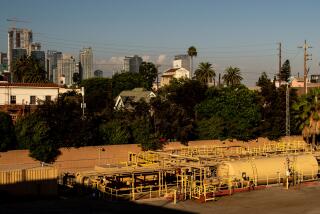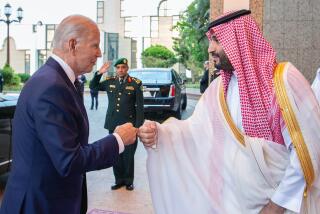NEWS ANALYSIS : Hussein Won’t Find It Easy to Destroy Saudi Oil Fields
- Share via
WASHINGTON — Although Iraqi President Saddam Hussein’s threat to bomb Saudi Arabian oil fields sent oil prices soaring Monday, military and industry analysts said that those oil facilities would prove difficult for him to destroy.
Still, with Saudi Arabia producing at full capacity to make up for the loss of Iraqi and Kuwaiti oil on world markets, even a slight or temporary loss could send prices spiraling further.
Of even greater concern is the fact that an outbreak of hostilities could empty the oil fields of workers, who are largely foreigners.
“All the people who operate the fields will be gone in a minute” in the event of war, said Philip K. Verleger, an energy analyst with the Institute for International Economics in Washington.
A government analyst agreed: “If he can keep lobbing missiles, even one a day, he won’t get many people to work in the oil fields. He will not get many ships up there either.”
Hussein vowed Sunday that if Iraq is strangled by an international embargo, “the oil areas in Saudi Arabia and in other states of the region, all the oil installations, will be rendered incapable of responding to the needs of those who came to us as occupiers.”
Saudi Arabia’s vast oil reserves include the world’s largest field, Ghawar, and the biggest offshore reserves, the Safaniya field. These and other crucial oil-producing areas lie within 300 miles of the border of Kuwait, which is now under Iraqi control, and well within range of Hussein’s bombers and missiles.
The oil makes its way to world markets through a huge network of facilities that present more vulnerable targets than the underground reserves themselves.
Saudi oil wells would be rendered useless without giant power and water plants. Other possible targets are the fewer than 50 major pumping stations that service more than 6,000 miles of major pipeline.
A single 50-mile stretch of Persian Gulf coastline contains the terminals through which 80% of Saudi Arabia’s oil production is shipped. Included in that area is Ras Tanura, the world’s premier oil port, berthing 18 tankers at a time and shipping up to 256 million barrels a year.
“The choke points are what you’d aim for,” said G. Henry Schuler, director of the energy security program at the Center for Strategic and International Studies in Washington. Much of the equipment, he said, is specially built and not easily replaced.
Destroying any of these sites or other critical facilities, however, would require a good deal of skill and no small amount of luck, analysts say.
“Iraq is very limited in what it can do. Basically speaking, a defended oil field is very difficult to attack,” says Anthony H. Cordesman, a national security expert who has written extensively about the vulnerability of the region’s oil facilities.
Iraq’s Soviet-made Scud-B missiles--some of which are nicknamed Al-Husseins--would not be up to the task because they are notoriously inaccurate, experts say. Nothing less than “persistent bombing and highly precise bombing” could shut down crucial pumping stations, pipelines, terminals and electric power stations, Cordesman said.
U.S. air defenders, working with the Saudis, likely would render that impossible, he added. The U.S. deployment includes AWACS and Hawkeye radar planes that monitor all air traffic, which could be intercepted by U.S. and Saudi fighter planes. The U.S. forces also have in place the advanced Patriot ground-to-air anti-missile system.
The Saudis themselves have been working for several years on an extensive system of anti-aircraft and anti-missile defenses for their oil fields and industrial facilities, but U.S. officials say those systems are not yet fully in place.
Another possibility is that Iraq could disrupt shipping through the Persian Gulf, either by destroying port facilities or intimidating tanker fleets.
Some analysts discount that possibility, noting that even Iraq’s eight-year war with Iran, in which the two sides hit more than 300 tankers, did not cause major disruption of oil movements in the Persian Gulf. During that war, Iraq repeatedly tried and failed to destroy Iran’s main oil-loading terminal on Kharg Island.
Still, if Iraq succeeded in disrupting Persian Gulf ports, Saudi Arabia could ship some of its oil out through an alternate route--the Petroline east-west pipeline from the oil fields to Yanbu, the major Saudi port city on the Red Sea.
The oil wells themselves, which numbered 858 in 1989, are relatively small targets, more vulnerable to a terrorist than a bomb or missile.
However, with chemical weapons they could be contaminated for months, making their operation impossible. Iraq is known to have test-fired missiles carrying chemical warheads.
Fire is always a danger in oil fields. Oil well firefighter Red Adair said he spent six weeks attempting to put out the blazes when a terrorist blew up five wells in Libya in 1966. Only a handful of companies will even attempt the dangerous work.
However, most Saudi wells require injections of processed salt water to operate, Cordesman said, so they would not burn as easily. The blaze could be extinguished by shutting off the water, which would stop the oil and gas from flowing.
Since the Iran-Iraq War, Saudi Arabia has undertaken an effort to make its oil facilities more resistant to attack. The sensitive master controls of some terminals, for example, have been buried in underground bunkers, Schuler said.
“We are trying our utmost to take precautions and defensive measures to make the minimum vulnerability possible,” one senior Saudi official said. The biggest problem, he noted, are parts and supplies that require lead times of as long as two years to order.
“We have made it a policy that we stock these kind of long lead items,” the official said. “Other things, usually, you can repair locally and so on, or buy from the shelf. So we think we can do a reasonable job if hit . . . in recovering fairly quickly.”
But one oil industry source noted: “There are only so many preventive actions you could take against a Scud-B missile coming in.”
SAUDI OIL SITES AND IRAQI AIR POWER
Saddam Hussein’s threat to bomb Persian Gulf oil fields jolted world market. Of particular concern are Saudi facilities within range of Iraqi missiles and bombers.
Iraqi strike ranges: SU-24 Fencer fighter Al Abbas missile Mirage F-1E fighter Hussein missile Saudi refineries 1. Ras Tanura 2. Juball 3. Jidda 4. Riyadh 5. Yanbu 6. Ras Al Khafji Critical Zone Tiny Tarut Bay area has terminals shipping nearly 80% of Saudi oil, new port at Juaymah and computers at Dammam that control production. Attack here could cripple oil output for months. TYPES OF TARGETS Not all Saudi oil facilities make equally good targets. Oil terminals: Vital but hard to destroy.
Refineries: Not as vital as they seem; crude can be refined outside country.
Oil fields: Hard to destroy. Wells make tiny targets and can be redrilled.
Power, water plants: Vital for wells, run by injection of processed saltwater.
Pumping stations: Critical; fewer than 50 major ones.
Computers: Critical. Main center at Dammam. Loss could paralyze production for months.
DEFENSES Saudis working on network to protect fields. Now, U.S. supplies main defense. Major systems: Patriot: Surface-to-air missile. Defends against Scud-B (Hussein) missile.
AWACS: Radar plane detects incoming warplanes.
Hawkeye: Navy radar plane.
Fighter aircraft: U.S., Saudi planes would scramble against attack planes detected by radar. Saudis have five major U.S.-built air bases.
Other measures: Saudis have placed master controls of some oil terminals in underground bunkers.
More to Read
Sign up for Essential California
The most important California stories and recommendations in your inbox every morning.
You may occasionally receive promotional content from the Los Angeles Times.













